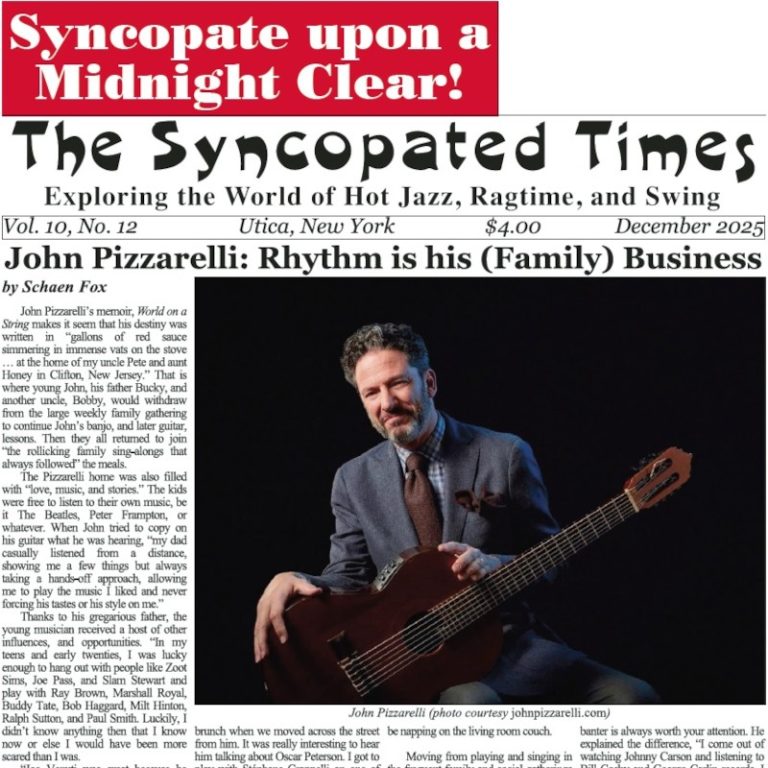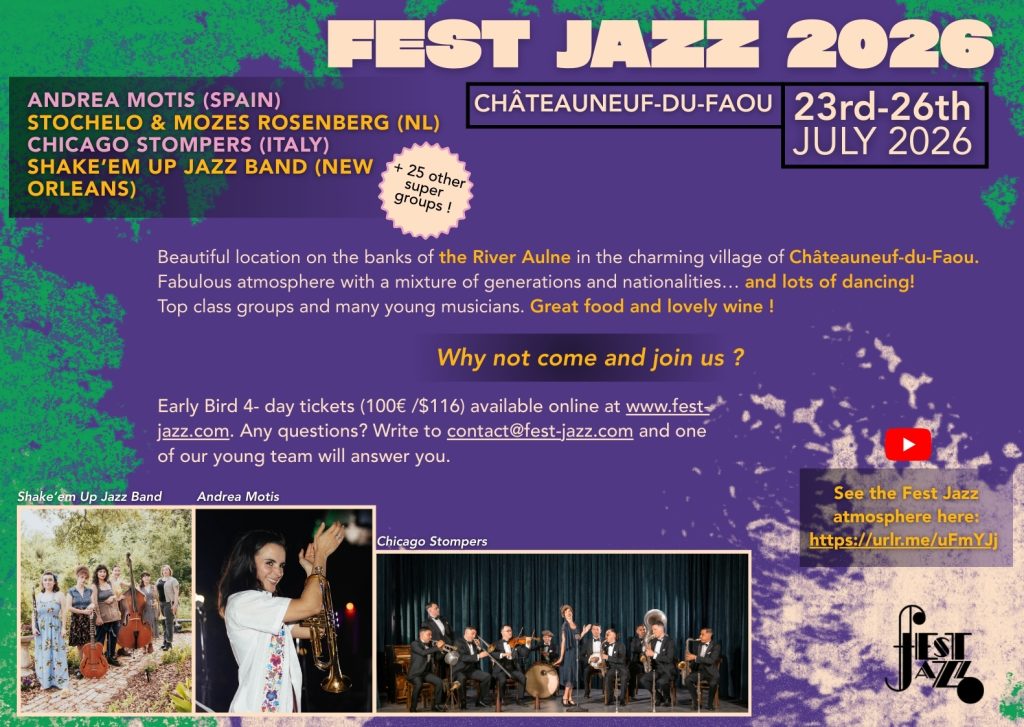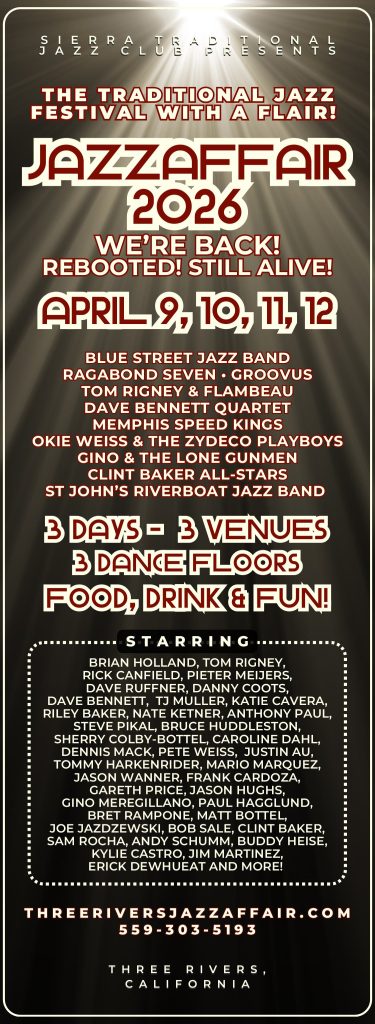Jeff Barnhart: My erstwhile collaborator, Hal Smith, needs a while to erst on other projects this time around and requested I invite a guest. I’ve found one! Joining me from his European tour is internationally celebrated musician and arranger Dan Barrett; he’s agreed to join me in the ongoing conversation regarding the development of Bennie Moten’s Kansas City Orchestra, even though we’ll be collaborating from ten time zones apart, so please excuse any jet-lag-induced nonsense! We’ll concentrate on the years 1928-1930, emphasizing those sides on which William “Count” Basie assumed the piano chair full-time.
Dan, thank you for joining me! 1928-30 were pivotal years in the evolving style of the Moten band, during which it absorbed key members of Walter Page’s Blue Devils, including pianist William “Count” Basie, Eddie Durham (gtr; tmb; arr.), Oran “Hot Lips” Page (tpt) and Jimmy Rushing (vocals). Before we get into specific examples, could you offer a brief recollection of your first encounter with these sides?
Dan Barrett: Jeff, I’m so glad you invited me to “sit in” for our friend Hal Smith in discussing the important and influential Benny Moten band. I was in high school when I first heard several of the band’s recordings. Of course, I flipped! In fact, it may have been Hal Smith himself who played Moten’s recording of “Kater Street Rag” for me. That side was recorded just prior to the scope of this discussion, but it served as my introduction to the world of Benny Moten.
Jeff: It’s too bad we didn’t think to include you when we did the earlier stuff, but I’m very excited you’re on board now because, while the playing is hot and top-notch in any era of this band, the Moten material we’ll be covering illustrates huge leaps in arranging in terms of brass/reed interplay, surprises, and the emergence of a real “swing” sound!
I’d like to begin with “Kansas City Breakdown” from September 7, 1928. Band fanfares alternate with some exciting clarinet/bari sax breaks from Woody Walder and Jack Washington leading us into a sort of “wobble” feel; the band was still firmly in its ragtime roots. In the next 32 bars, Harlan Leonard offers us some “slap-tongue” soprano sax, followed by tuba lead, brass breaks, and ensemble for the final four bars; just a single chorus gives us a remarkable array of textures and sounds. The B theme (played by tubist Vernon Page) sounds derivative of “Wang Wang Blues.” Back to the A theme for some ragtime piano by Moten, and an eventual New Orleans-inspired polyphonic out chorus. What stands out to you on this track, Dan?
Dan: Your comparison to “Wang Wang Blues” is adroit. That passage also made me think of “Careless Love”. As I listen to these great sides, I always notice how beautifully they were recorded! Those RCA Victor engineers really knew their stuff. It’s a wonderful thing to have these classic performances preserved so well.
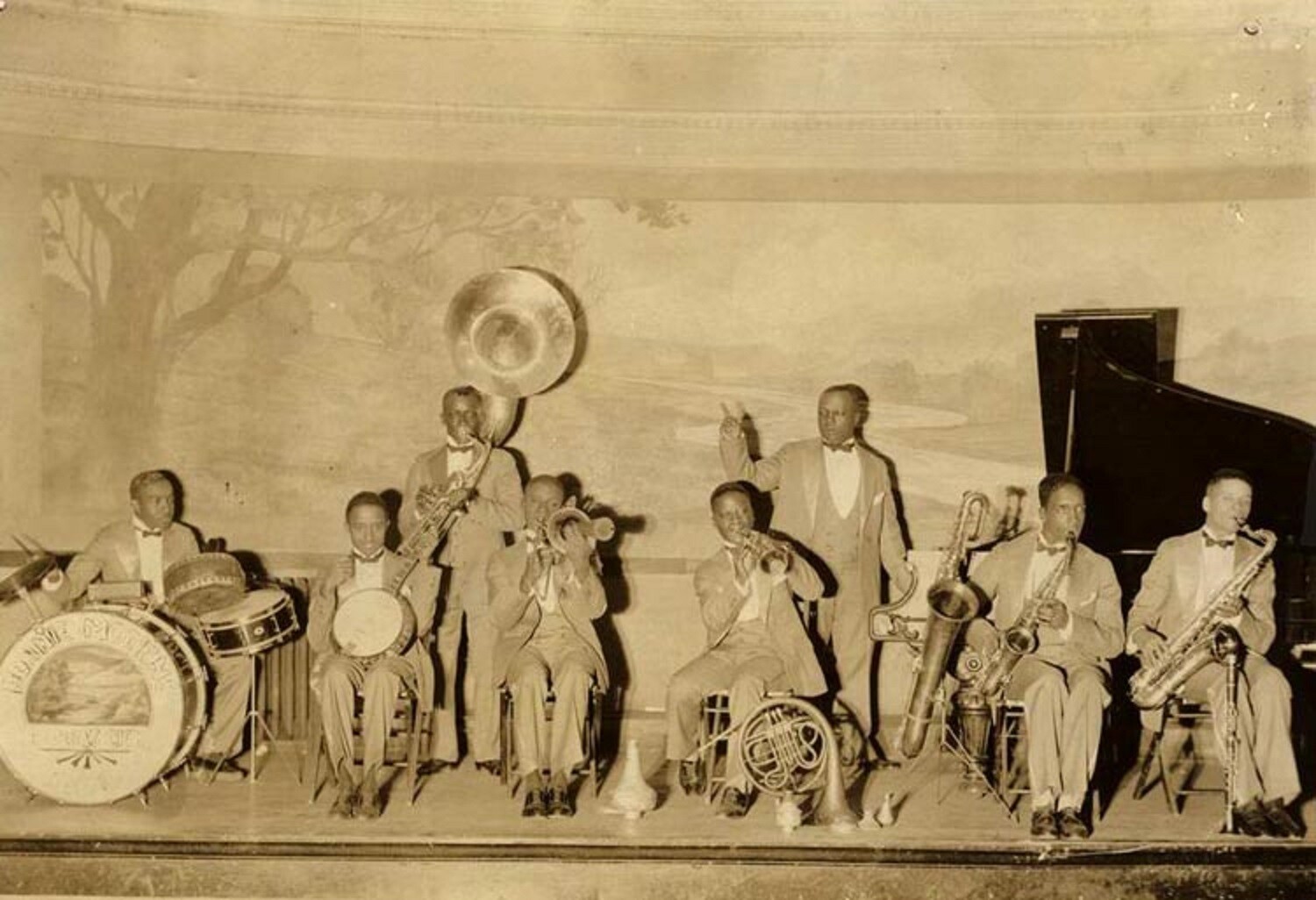
Jeff: While the 1928 material is hot, the first step toward the band attaining a more modern sound was Basie taking over the piano chair full-time from the October 23, 1929, session forward. He enjoys co-composer credit with Moten on “Rumba Negro (Spanish Stomp)” and “The Jones Law Blues,” the latter featuring a remarkable piano solo in which Basie breaks from Moten’s ragtime-based pianistics with suspensions of the stride left hand to include some advanced held-chords and some Hines-influenced licks, as well as lovely banjo picking from Leroy Berry on the second time through the hymn-like theme by the brass.
On this date, Eddie Durham was added as well, and we immediately hear more sophistication in the arrangements. Dan, you’ll cover Durham more fully when we get to 1930, but this October session features some stellar “Durhamisms” such as the beautiful guitar solo and pyramid chords for the horns in “Band Box Shuffle,” as well as giving Basie an over-a-chorus-length piano solo in “Small Black” (a tune based on the changes of “Here Comes the Hot Tamale Man,” the 3rd take was released: it’s fascinating to hear all three takes: Basie’s solo is different each time!) that leads into close reed work and a hot trumpet solo interrupted by a dramatic interlude that echoes “The Anvil Chorus” (one has to remember Moten’s was a dance band playing for both amateur hoofers and professional show dancers), Durham’s sophisticated guitar playing on the bridge of the hot ensemble out chorus and his sly guitar coda. Clearly, this man had ideas!
In fact, let’s skip ahead to the first tune the band recorded five days after this inaugural session of the “new Moten sound,” a paean to Mr. Durham himself called “Oh! Eddie.”
Dan: Eddie Durham is one of the unsung (or “undersung”) heroes of jazz. He played trombone and guitar; in fact, Durham was one of the early exponents of amplified guitar. He was also a brilliant composer and arranger. (By now, do we all know that it was actually Durham who crafted the original arrangement of In The Mood? After Glenn Miller’s savvy editing [for the three-minute recording limitation of the day], Miller’s version became one of the most iconic recordings of that era. But it started with Eddie Durham’s arrangement.
I hadn’t heard this side for several years. The first thing that hit me was the perfect TIME these guys all had! That introduction—half notes (in “cut” time) are all played perfectly together, but not in the way good classical musicians would play them. Somehow, the half notes here have an inherent “forward motion,” which leads to my next thought.
Many jazz writers and historians want to place the start of the “Swing Era” at around 1935, when Benny Goodman’s band finally got to the Palomar Ballroom in California. Of course, most jazz musicians (and the hipper jazz fans) know that bands were “swinging” well before that. Two locations where you could hear bands play with that momentum we call “swinging” were New Orleans (of course) and Kansas City.
Durham’s writing here also presages the Swing Era in his use of call-and-response phrases between the brass and sax sections. The same device is also used effectively in a “dialogue” between Moten’s accordion and the band.
As you alluded, Jeff, at this time, the fellow later known as Count Basie was just plain Bill Basie. Listeners not familiar with Basie’s early work will be surprised at just how much piano the man could play! He plays a great solo here, and again that perfect, swinging TIME is very much in evidence.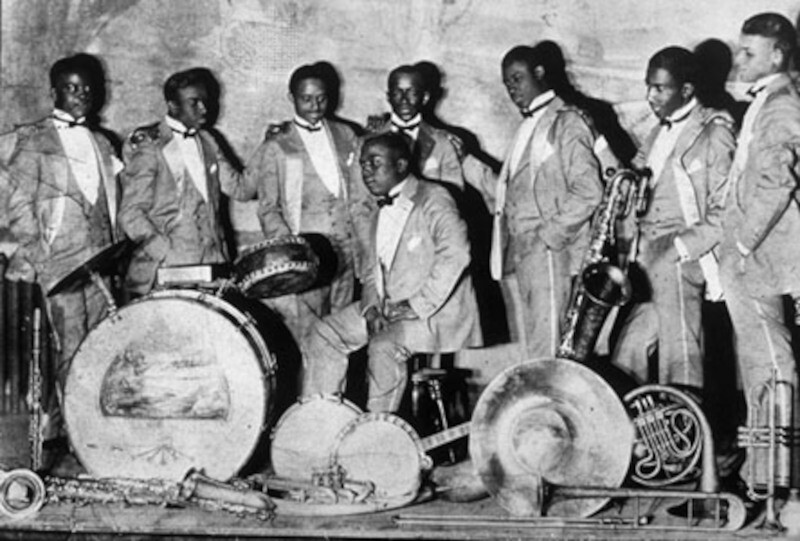
Jeff: Indeed, it takes PERFECT time to execute Durham’s humorous surprise ending on this tune where the same phrase is played eight times in breaks by: ensemble; ensemble; piano; clarinets; brass; tuba; saxes; ensemble! I was in college when I first heard this side and listened to the ending a dozen times, shaking my head in wonder. Dan, what’s another tune you’d like to include from this session?
Dan: “That Too, Do” is a fine example of early Kansas City blues. A few years ago, I remember listening to a recording by trumpeter Hot Lips Page. I recall thinking that along with Louis Armstrong’s pivotal early recordings, Lips must have paid lots of attention to the 1923 recordings by King Oliver’s Creole Jazz Band. He bends and “shades” his blue notes in a similar way to Oliver (Listen to “Southern Stomps” by the Oliver band).
Speaking of Oliver, the introduction borrows a familiar phrase from the intro to Oliver’s recording of “Snag It“. Lips Page plays beautifully, using some kind of mute in front of the bell of his trumpet. After a deceptively simple and direct clarinet statement (note the wide-open spaces he leaves), Basie plays the eight bar “bridge.” A sax “soli” finishes the chorus.
The next chorus returns to the traditional twelve-bar blues structure. Singer Jimmie Rushing sings a lyric originated (I think) by Huddie Ledbetter (“Leadbelly”). Rushing went on to record these same blues lyrics again several years later with Count Basie’s band. “Good Morning Blues” became a staple of Rushing’s repertoire for the rest of his life. Note guitarist Eddie Durham’s down-home plucking behind Rushing’s vocal. Lips returns with a muted “stop-time” chorus (“Yeah!”) and the side closes with a reprise of that “Snag It” lick. Great stuff!
Jeff: I’ve always thought of Jimmy Rushing as a real “shouter,” in the old meaning of the term when vocalists had to fill 2,000-seat theaters without the aid of amplification! We can briefly compare his blues singing with his pop singing if we turn back the clock one day to October 27, 1930, when the band, usually prolific, only managed one side during the session. The tune was “Won’t You Be My Baby?”: Rushing’s first recorded appearance with the band—he received co-composer credit with Moten. A piano introduction leads us to brass and reeds trading phrases throughout the first chorus. A brief modulation takes us into Rushing’s stentorian, but oh so sweet, vocal. After he’s charmed us all, trombone and brass/reeds navigate a “call and response” chorus with the ensemble mimicking trombonist’s Thamon Haye’s licks. Other highlights include a low register clarinet ride followed by the hot muted trumpet of Hot Lips Page and Rushing singing the tune out in his uniquely hot yet lyrical way, phrasing across the beats in the epitome of “swing!” Swinging as well is Vernon Page playing 4-beat on his tuba for the first time on record in a medium-upbeat tune!
Dan, a track that features drummer Willie McWashington is “Mack’s Rhythm” from the same date that produced the previous two sides you discussed. What do you hear, here?
Dan: I confess this was an unfamiliar side to me! I’m glad you called it to my attention. There are several musical rewards to be found along this three-minute ride. After a rather odd introduction, the band kind of “falls into” the first chorus. As soon as it started, I thought, “Oh, okay; it’s another thing based on ‘Tiger Rag.’” No sooner had I thought that than the structure departed from the familiar “Tiger Rag” pattern and went its own interesting way.
The soloists include the great Hot Lips Page on trumpet, and Jack Washington on baritone sax. Washington stayed with the band when it transitioned into the Count Basie Orchestra. As with this side, his strong, swinging bari playing anchored the great sax section of the early Basie band.
Something makes me think it is not Basie on piano on this side: possibly Buster Moten? Maybe Jeff, you can straighten me out here…
After the piano solo (whoever it may be), Thamon Hayes comes in for an intense, “hot” muted trombone solo. It’s followed by an excellent tenor sax solo, and then we hear a brief drum solo comprised of press rolls. Listen for some hot cymbal stuff later in the track.
The ending is fun and unpredictable. It contains some “weird” altered chords that I associate with arrangers like Bill Challis. But then, advanced composers like Duke Ellington, Don Redman, and here Eddie Durham (my guess) were also conversant in this “modern” harmonic language.
Jeff: Great observations here, Dan! I too thought at first that the band was going to stay in “Tiger Rag” territory; after all, just four days prior they had recorded two numbers in the same session based on those ubiquitous changes: “Boot It” and “Rit-Dit-Ray”!
To address your supposition that this is not Basie, it sure doesn’t sound like his playing on the previous tracks, but for me it’s the left hand that gives it away; neither Moten had that versatility. However, supporting the notion that Ira “Buster” Moten might have been the pianist here is the absence of that infernal accordion (forgive me, and please feel free to disagree, but every time I hear him interrupt some hot solo or ensemble work with that squeeze box, it has the same effect for me as a tire being deflated). We’ll probably never know unless any readers can offer insight?
We move to one of my favorite Rushing vocal tunes; he bends notes, he shouts, he struts, and this is just one of the great moments to be found in “Liza Lee,” the only tune the band recorded on October 29, 1930. Dan, please lead us through this one.
Dan: It opens with yet another great muted solo by trumpeter Hot Lips Page. After his fine work (interrupted briefly by Buster Moten’s accordion), the melody of the chorus opens with Harlan Leonard’s soprano saxophone. Leonard went on to lead a fine, forward-looking Kansas City-based band, The Rockets. They made many terrific recordings for RCA Victor.
So, Leonard plays the first half of a chorus. The ensemble plays the harmonically interesting bridge, and the chorus ends with Jack Washington’s rocking bari sax.
Then we have an intriguing, “modern”-sounding modulation. (For the musicians reading this, I think it’s the unexpected minor-seventh chords that give it an almost-1940s quality here).
After we arrive at the new key, we’re rewarded with another fine vocal by Jimmy Rushing. His singing here (and elsewhere) reminds me of a comment made by my Australian buddy, the virtuoso violinist and vocalist George Washingmachine (yes, that’s his name). He once referred to Jimmy Rushing as, “the Edward G. Robinson of jazz!” Rushing’s diction and overall delivery here shows you why. And don’t miss Eddie Durham’s single-string guitar work behind Rushing’s vocal.
The era’s three-minute limit for recordings gives the band just enough time to play another eight bars out. As with many recordings made around this time, I wish it could go on. And on.
Jeff: You and me both, my friend, as do I wish this column could! Nevertheless, our space is limited so we need to skip over a dozen sides and settle on a few more of the crème de la crème of our window of exploration.
Jeff: Dan, I don’t know why “Get Goin’” from 10/30/30 is my go-to when I’m feeling down. Maybe it’s the hot piano fills behind the straight dance band statement of the melody by the reeds, or the fact that Buster Moten is swinging so hard on this track that I don’t mind the accordion here, or is it the lovely verse with sophisticated guitar picking by Eddie Durham? The whole delightful ride leads once again to Jimmy Rushing, who despite his association with hot blues singing, always considered himself a balladeer. I just love this track—the tune itself is so pretty—and feel happier every time I hear it! As an arranger, I assume you enjoy the chorus featuring Woody Walder’s tenor sax backed by hot ensemble riffs; the second eight features some great part arranging behind the straight trumpet melody: this song shows what a terrific DANCE band this was!
Dan: I was aware of another tune with the same title—“Get Goin’’’—that was recorded by trombonist Benny Morton and His Orchestra in 1934, just a few years after this recording. So, we have the same title—different songs—recorded by Bennie Moten and Benny Morton! Discographers all over the world must have been scratching their heads…
I suspect this was a “stock” arrangement. We’d need someone like Vince Giordano (but is there anyone like Vince Giordano?) to confirm this. It’s a very good chart; just sounds to me as though it could be a published arrangement. Those hot piano fills you mentioned in the first chorus reminded me of the way Bix would occasionally play hot stuff in between the other horns’ straight written phrases. That contrast—“hot” against “sweet”—can be very effective, as it is here. I think you pointed out the high points of this side: Rushing’s great vocal; Buster Moten’s strong accordion work; and Eddie Durham’s nifty guitar stuff. Yes, another very enjoyable Moten side!
Jeff: Dan, when I listen to “When I’m Alone,” in addition to Page’s swinging’ first trumpet chorus, Rushing’s vocal that barely touches the melody, the soli sax chorus, Durham’s single string guitar solo, interpolated by the hot accordion solo—what great lines Buster plays (OK, ok, I’ve rethought the accordion in this band; the later the dates, the more I like it), its especially the final chorus that knocks me out. I think Durham’s arranging here is a harbinger of the riches to come in 1931-32: a new sound for the band.
Dan: I love this side! Again, it lets us know some bands were swinging well before the “Swing Era!” As I listened to this side, I noticed the tuba (or sousaphone) often played four to the bar. One observation is probably a coincidence of the recording balance: the tuba, piano, guitar, and drums all blended into one unified sound. That is, in many spots you felt and heard RHYTHM without the individual instruments sticking out. This anticipates the sound of Basie’s rhythm section about six or seven years later. Again, it can be chalked up to coincidence. Or were the guys striving for this kind of blend? Well, it’s something to ponder until your bus shows up at the stop. Like many (most? All?) of Eddie Durham’s fine arrangements throughout the years, this one has Louis Armstrong written all over it; especially the shouting brass figures in the final chorus. I think he must have done exactly what Fletcher Henderson said he (Henderson) did later when crafting an arrangement; Henderson said that he would often sit back and try to conceive how Armstrong would phrase a given passage. Then, he’d write that for the five (or three, or six) brass. Sounds like Durham had his own “channeling” of Louis going on here. Many people still don’t realize the importance of Armstrong’s influence on the Swing Era, and indeed 20th (into 21st) Century music. Ultimately, he’s the cat!
Jeff: Our time grows short. Time for one more and that one is “Now That I Need You,” with some fantastic arranging right from the start; I have to say you and Durham share the admirable attribute of thoughtful arranging that allows for freedom and hot blowing in-between the orchestrated passages! The final two choruses with the back-and-forth between brass and reeds ending with that lick in unison gets me out of my seat every time!
Dan: Man! What a killer side! Early Kansas City swing in all its glory! Thanks for the kudos about my own arranging efforts. I like what I’ve come to call “invisible arranging,” where the writing doesn’t call attention to itself, but presents the given number in a clear, interesting way. Easy to talk about much harder to achieve. Was it Durham who arranged this one? Must have been. It’s great, solid writing from beginning to end. Once again, I must make comment of Jimmy Rushing’s flawless diction; one can understand every single word of the lyrics. Getting back to the chart, something about it reminded me of the writing that trumpeter Dave Nelson did for King Oliver’s New York band around the same time: also for RCA Victor. In fact, one phrase in the first chorus is identical to a phrase in a similar Oliver recording. (Was it “Olga”? Or “Edna”? “Mule Face Blues”? One of those…) So, it begs the question: who was listening to whom? Yet another point to ponder at the bus stop. Or OTB parlor. Thanks again, Jeff, for inviting me to join in this fun discussion. I hope our readers will follow through and listen to some of the recordings we’ve discussed with a different appreciation. These days, all those sides are only a click away.
Jeff: Dan, it was a pleasure! Thank you for all of your lively and insightful comments. Let’s do it again in the future; there are still 2 more years’ worth of Moten material to mull over!
Jeff Barnhart is an internationally renowned pianist, vocalist, arranger, bandleader, recording artist, ASCAP composer, educator and entertainer. Visit him online atwww.jeffbarnhart.com. Email: Mysticrag@aol.com
Dan Barrett is a professional trombonist/ cornetist, arranger, and composer. He enjoys performing in admittedly old-fashioned jazz styles. He has recorded for Concord Records, Arbors Records, and his own Blue Swing Recordings label, among many other labels. Dan fell in love with jazz in high school, and learned to play from much older musicians from New Orleans, who had settled in the Los Angeles area. He has played at Carnegie Hall five times, and was featured in the last bands led by Swing Era icons Benny Goodman and Buck Clayton. Another highlight of Dan’s musical life—so far—was being a member of Lueder Ohlwein’s Sunset Music Company. Write to Dan at: www.DanBarrettMusic.com.



